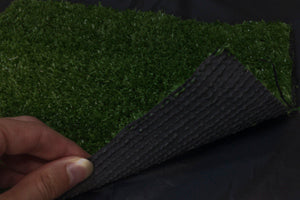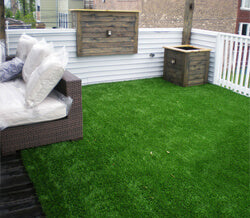You have no items in your shopping cart.
0item(s)
You have no items in your shopping cart.

Our artificial grass is made of 100% synthetic materials for your convenience. There is no maintenance required. To clean the grass, simply hose it down. You can drill drainage holes to make washing easier, as long as the grass is not being glued down or laid on concrete. The grass is waterproof and even mildew and chemical resistant, so it’s great for outdoors. Most common uses for faux grass are for patios, poolside, parking lots and lawn spot replacement. Dog owners have begun using squares of the fake grass for training or bathroom breaks, placing the grass outside on the balcony. This is especially convenient for dog owners living in buildings and condos. Our grass is cut-pile and color graded for a realistic look. There are a lot of technical specs on synthetic turf, from the cut type, to pile height, to density and stitch to backing. See below for a brief explanation of terms.
Cut-Pile: The fibers, or “grass blades” are cut and inserted in a vertical position (sticking straight up) to mimic real grass. This is opposed to loop-stitched, which would look more like a rug with horizontal loops.
Pile Height: The height of the “grass blades”, typically measured in small units such as millimeters.
Dtex: Also known as Yarn Count. This refers to the amount of material (polyester, plastic etc.) per strand, and contributes to weight and density. The higher the Dtex number, the more material each “grass blade” is made of. This increases the durability, structure and overall weight of the grass rug.
Gauge: The distance between two rows. This is sometimes hard to see and typically appear as slight groove marks on the back. The standard metric is inches. The most common gauge sizes are 5/32 Inch, 3/8 inch and ¾ inch.
Stitch: Stitch or Stitch Rate refers to the number of stitches present in one dimension (along the direction of the stitch line) of a square meter (100 x 100 cm).
Density: This is the number of stitches present in two dimensions of a square meter (the number of stitches present both length-wise and width-wise). The Stitch will give you one unit. You can use Gauge to figure out the second dimension. First convert the gauge inches to centimeters, and then divide 100 by that number of centimeters. Once you have that number, simply multiply it by the Stitch and that is your density.
Backing: The backing is actually made up of two layers. The inner layer where the “grass blades” are bonded/stitched to, usually made of polypropylene (PP) and/or netting (NET). This layer is then laminated with a coating, generally Latex (SBR) or Polyurethane (PU) for added strength, durability and resilience.


← Older Post Newer Post →